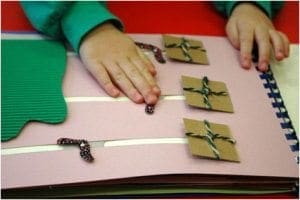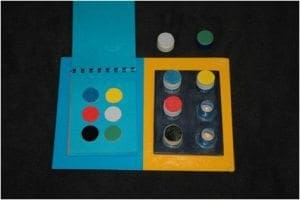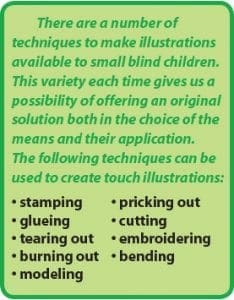Making touch books for blind children is a time-consuming task which can sometimes prove to be expensive. Nevertheless, it is worthwhile to undertake their construction since a well prepared material can serve a few generations of children.
Besides, an additional reward for this effort is the huge enthusiasm that accompanies the contact of blind children with a book prepared by ourselves.
For a start, we must decide upon the contents of our book. We have at least two options to choose from: we will either adapt an existing book for small children so that its contents will be cognitively accessible to blind children, or we will prepare such contents ourselves. Personally, I recommend the variant which gives a greater creative freedom to the author, and this is to prepare the whole project individually. Additionally, this solution makes it possible to present the contents significant for the needs of small children which would be hardly available in the publications commonly accessible to children (e.g. preparation for Braille’s system of writing).
The next step is to establish what the pages of our book are going to be made of. The best accessible material that we can use to this aim is cardboard. The thickness of cardboard should be dependent on the technique of making illustrations. In case of impressing or stamping, it cannot be too thick; whereas when we intend to make illustrations by sticking different additional elements, it should be adequately thicker so as to make a durable and stable medium.
Obviously, we can also use other materials to make the pages, for example, plastic (e.g. for the covers to bind) or a fabric. Then, such a book will also be durable, however, we have to take into account the necessity to use the proper technology of binding particular elements (glueing or sewing).
I also suggest making the pages out of a laminated cardboard. Before laminating the pages in a transparent foil, we can print the text on the cardboard and next write the same content on the whole page by means of Braille’s signs. We do not place illustrations on such a page. If the book contains both the text and illustrations, then it is better to put these elements on separate pages. The attractiveness resulting from combining a touch picture with the text, especially poetry, was also drawn attention to by W. Szuman.
 [2]The size of the book is also of importance. We should take care not to make them of a too big format.
[2]The size of the book is also of importance. We should take care not to make them of a too big format.
It would also be advisable to anticipate already at the preparatory stage how the pages are going to be joined. Binding is a very convenient method of joining the pages which contain relief illustrations. Depending on the height of illustrations, a properly wide back can be adjusted. This will ensure a possibility of closing the book and the convenience of using it.
Another solution is to place the properly prepared pages into a file. Unless we feel limited by the format or the weight of the file’s covers, this is also a good suggestion. Other methods that are worth considering consist in using metal rings or plastic clips. One should also remember about the necessity of a conventional marking of the proper arrangement of the books on the cover.
More interesting effects are achieved simultaneously using a few techniques to make a picture, e.g. cutting and glueing. This also strengthens rehabilitation. The more numerous and more variable the sources of touch stimuli are, the more complete the compensation.
The choice of the proper technique is determined both by the kind of medium and the availability of tools and materials.The volume of this kind of production does not usually exceed 10 pages.
 [4]Setting upon the creation of touch books, the following difficulties should be taken into consideration:
[4]Setting upon the creation of touch books, the following difficulties should be taken into consideration:
- There are children who can fear touching new objects as well as children who do not like touching definite materials. If we use such materials to make an illustration, we will not achieve any positive results in using a touch book in working with a child, and we even can develop the child’s aversion towards the cognitive activity by means of touch. Therefore, we should try to ensure the child’s contact with different materials and products.
- One should remember about safety. Particular elements of an illustration should be well fixed and selected in a way that would not create any danger to the child in case the book can get damaged (e.g. one should remember to use only non-toxic materials).
- If possible, the use of natural objects to make illustrations should be avoided. This especially refers to the use of plant parts (flowers, leaves, twigs, bark, etc.). These materials are not too durable, which is why they can also prove dangerous to the child.
Therefore, after we find out individual preferences of the child, it is best to prepare the book in a way that it would become a stimulus arousing its interest. With the very stimulated need of blind children to acquire direct experiences, we should not encounter any serious problems in finding the proper materials. We should also take the fact into account that the children who, at first, did not find any pleasure in watching the books, will start to reach for them themselves. However, this will happen only when they have a free access to them.
You May Also Like
- What Is Blindness/Visual Impairment? [5]
- Proud Moments: Matthew Shifrin Inspiring Lego for the Blind [6]
- Got Parent Support? My Advice to Parents Is Get Parent Support [7]
- Vision Problems Parents Should Be on the Lookout For… [8]
This post originally appeared on our Mar/April 2011 Magazine [9]


